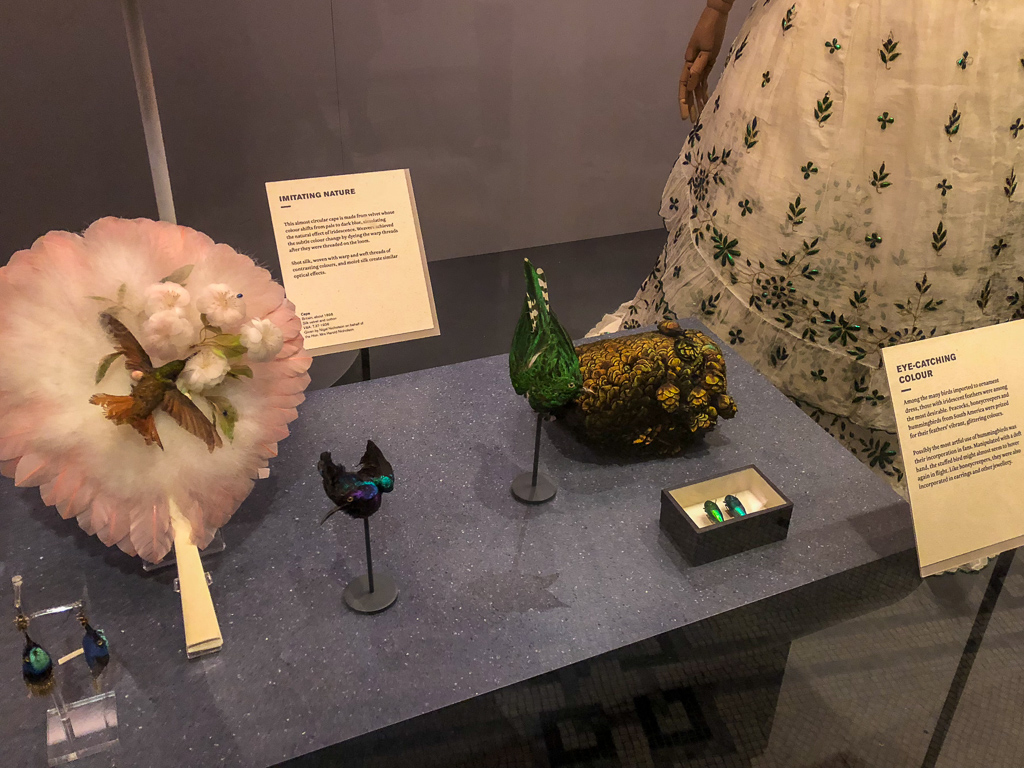The unique and thought-provoking exhibit, Fashioned from Nature, illustrated what a fundamental part nature has played, and continues to play, in fashion. The different materials used throughout the decades are reflected in the collection of pieces on display. And it is truly eye-opening!
By the end, this exhibit at the Victoria and Albert Museum in London has brought you right up to the current challenges in the fashion industry, prompting you to ask questions about the future based on what we have learned from the past.

“Have we over extracted the world’s resources for centuries by requiring fashion keep up with our demand, that it has come to chemically engineered purses?”
Fabric: The Foundation of Every Garment
Since the 1600s, and even before, fabric has been the basis of every garment made … at least until 3D printing came along. The exhibit takes you through the history of silk, wool, cotton and flax (linen).
Interestingly, in the 18th century, ideas of sustainability were already present, driven by the value of the different elements used to make a garment. For example, the silver thread that was embroidered into the weave was often carefully removed and resold.



And the amount of fabric being used, and reused, can be interpreted as a respectful use of the natural resources that went into crafting these pieces. Many fabrics were extremely expensive, so when a dress was first put together, larger stitches were used to enable the seamstress to pull the garment apart and make something new later on.
This reminds me of my teenage years. My meager allowance sometimes forced me to be creative if I wanted something new to wear. So I might find some old skirts in my mother’s closet and make them into a dress. Or I ripped up the seams on an old pair of pants to make it into a skirt.
Embellishments Fashioned from Nature
Dying processes could transform fabric from its natural color to something even more vivid. And at some point, it wasn’t enough to print or paint the beautiful elements of nature onto a piece of fabric. Flowers, animals and other motifs were embroidered on fabrics to give them some additional depth and detail.


And why embroider a flower with multi-colored threads when you can adorn it with fur, feathers and wings. Take that a step further, and you have the 1800s. Women (and sometimes men) were wearing the entire bird, insect, etc.


Indeed, one of the most noteworthy fashion trends from the 1800s was the use of feathers and birds. To get a fascinating insight into this industry, check out the Dressed: The History of Fashion podcasts about past millinery practices.
Enter Animal Cruelty Legislation
Organizations to fight against these fashion trends, and cruelty directed towards animals in general, popped up at the same time in the 1800s. Thanks to them, and consumers’ interest in these practices, changes were made.

And the fight is still going on …
Attempts are still being made to remove fur from the fashion industry.
The most recent move by Macy’s is proof that consumers can effect change in this challenging (on multiple levels) industry.
Trends Transformed More Quickly in the 1900s
Up until the early 1900s, textiles and the trimmings were being transported to Europe from India, and within Europe from Italy and France. Travel was not for everyone. People generally stayed within their communities their entire lives.
The 1900s opened the door to tourism. With the expansion of the train and the invention of the car and airplane, now you could go where fashion was. And by the 1980s, fashion was coming from the streets and reflecting the cultures in which they were born, which was everywhere.



Fashion seems constantly to be looking for ways to give a nod to the past, but with a modern and unique twist. And in the 1900s, things were starting to change. Instead of using animal fur, designers began using animal prints. And a bag that would have been made out of a bird would now be a bag with a bird motif etched into it instead.
The 1900s also saw the birth of couture culture, with Dior, among others, leading the way. Read about my experience at the Christian Dior: Designer of Dreams exhibit here. At the same time, ready-to-wear clothing was on the rise, making it easier for consumers to buy more for much less. But this has also led to the fast fashion culture of today, and an overwhelmingly unbalanced use of the world’s natural resources.
Where Are We Today?
The use of horn, rubber, turtle shell (what were considered natural plastics) and amber increased in the early 1900s. But with the introduction of man-made plastics from chemically modified materials, alongside changes in legislation, the fashion industry replaced the use of the natural plastics in the 1990s.
“Nature provides the source for each garment that we choose to wear as our second skin. Fashion is made from nature and is dependent on it. Land, water, air and people form fashion’s supply chain, from growing to manufacturing, transportation and delivery into our hands and our everyday lives.”
Fashioned from Nature, V&A Publishing
Could the future of fashion be leading us back to the beginning? A beginning where we buy less and appreciate more. A beginning where we value our clothes not only for the retail price we paid, but also for the natural materials that went into making them.
To learn more about the Fashioned from Nature exhibit at the Victoria and Albert Museum in London, click here.

The True Cost
Even if we can chemically engineer textiles, shouldn’t we all be paying the real price for our fashion choices?
Something I am conscious of every day.



what do you think?